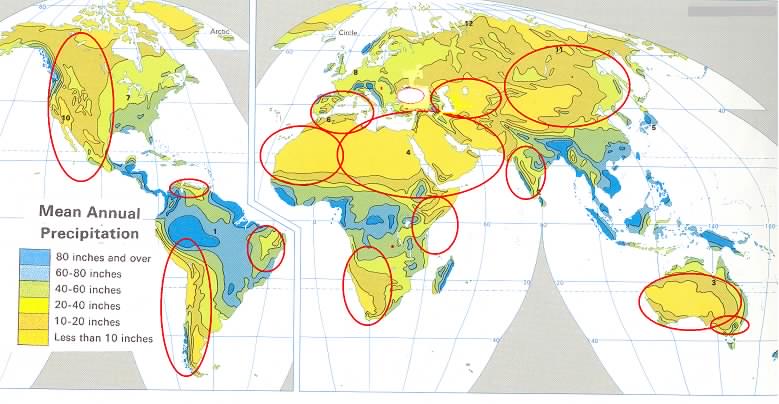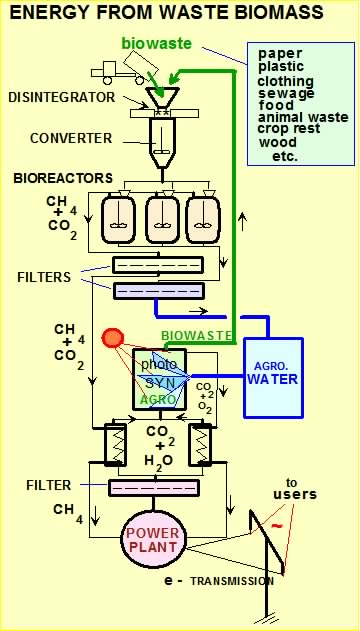CAPTIVE CARBON SETTLEMENTS
Contents of this chapter:
Mankind must be in the driving seat regarding the concentration of greenhouse gases in the atmosphere.
This means being in the position to throttle or increase emissions of greenhouse gases on a global basis at any time according to the prevailing environmental demands.
The prospect of an earth covered with windmills, atom-smashing plants and photovoltaic cells is a daunting one.
The CAPTIVE CARBON SETTLEMENT depicted on the left is probably the first proposal to gain complete control of our environment.
Imagine there are say 50000 of these settlements covering the face of the earth taking in the total world population. CAPTIVE CARBON here means that despite the fact that the depicted settlement is full-packed with carbon containing compounds no greenhouse gases or carbon containing materials escape into the environment and no carbon or carbon containing compounds necessarily enter into the space from the environment.
All carbon contained in waste agricultural and horticultural crops and other selected carbonaceous waste matter is collected, comminuted and modified to the liquid phase for biological transformation to fluidic fuels.
In effect when operating according to design all carbon containing waste fluids within the settlement are converted, modified, recycled and reused whereby the aim is conserve the carbon and water content of the settlement SPACE at constant level.
The key to operation of these systems is the innovative MILLER UNIVERSAL FLUID PROCESSING PLANT where the liquid and gas streams of the system are purified in round the clock operation.
- POTABLE WATER from SEA or SALINE WATER
- Fuel HYDROGEN from METHANE
- Fuel ALCOHOL from BIOMASS
- Photosynthetic BIOMASS purification
- PHOTOCHEMICALS
Over half of the earths’s land mass is arid and unsuited for human habitation.
The nearest available water is saline and unusable for conventional agricultural or potable purposes.
Much of this territory including North and South Africa, the Middle East, West America, southern Europe, parts of Asia, Australia during daylight hours is almost continually bathed in sunshine.
Sunlight, sea-water and carbon dioxide is the concoction of nature that led to success. It was from this combination that life on earth evolved and thrived. By building on and boosting nature’s accomplishment mankind can assure its future successful existence.

 Existing settlements in these areas are forced to import much of the essential foodstuffs often including potable water.
Existing settlements in these areas are forced to import much of the essential foodstuffs often including potable water.
Self-sustainable settlements based on an inexhaustible provision of SUNLIGHT, SEA WATER and CARBON DIOXIDE can completely revolutionise this situation.
The ringed areas on the above map of the world could be transformed into a mosaic of oases  completely independent of external supplies of essential raw materials.
completely independent of external supplies of essential raw materials.
The Middle East depicted on the right completely surrounded by saline water including the Black and Caspian Seas could be transformed into a genuine Garden of Eden.
Australia is continuing to suffer from intensifying drought conditions forcing inhabitants to flee the inland and a large part of the coastal areas.
The depicted large coastal and inland areas show how sea (red) and saline artesian water (blue dots) could transform the situation.
Preliminary estimates suggest that the cost of potable water (PW) from photosynthesis at EURO 0.40/metric ton undercuts PW from Reserve Osmosis by ~ 30%.
Carbon as the basic constituent of human, animal and plant life is with us to stay. The anticipation of replacing carbon as the main source of energy with non-carbon “renewable” sources flies in the face of reality. What ever “renewables” are chosen to reduce carbon emissions vast quantities of carbon constituents will continue to be produced, consumed and discarded as BIOWASTE and finish up as green house gases in the environment.
Nature has successfully practised CARBON RECYCLING for billions of years to preserve life on earth. We can continue this practice on a global scale to gain control of the quality of our environment.
The forests, savannas and animals of the earth all have life cycles resulting in lifeless carbohydrates being continuously degraded (aerobic and anaerobic) and returned to the environment in the form of greenhouse gases (mainly carbon dioxide) and water for repeated photosynthesis and carbon recycling. The power generating plant (on the right) as the centrepiece of a SETTLEMENT represents improvement on nature’s own CARBON “NEUTRAL” system in that the total carbon content of the habitat remains constant and captive and is known as a “CAPTIVE” CARBON system.
Man-made biowaste, most of which is at present dumped into landfill sites, is first disintegrated, comminuted, modified and converted in bioreactors to methane and carbon dioxide. Likewise biowaste generated in plant photosynthesising apparatus is fed to the bioreactors. Methane is used for fuelling power generation while the carbon content is continuously recycled as carbon dioxide for repeated photosynthesising purposes. The recovered water is recycled for the irrigation of photosynthesised AGRICULTURE.
This is CAPTIVE CARBON RECYCLING.


On cooling down billions of years ago the surface of the earth was left with large amounts of SEA WATER and GREEN HOUSE GASES mainly CARBON DIOXIDE. The sun did the rest in creating life.
The trick nature learnt was to extract WATER MOLECULES from the SALT WATER and combine these with CARBON DIOXIDE by means of SUNLIGHT to make CARBOHYDRATES or life as we know it.
The potable water process illustrated on the left copies nature by growing green algae in sea-water by exposure to self-generated light. The algae biomass is collected and subjected to anaerobic digestion forming methane for use as fuel in the power plant to generate electricity that in sealed plants is used as the source of light for the growth of the green algae.
The carbon dioxide emitted from the combustion in the power station is recycled to grow more algae whereby the steam generated by the combustion is condensed, purified and collected as potable water.
This is CAPTIVE CARBON RECYCLING.

Systems of futuristic power generation, fuel production and selfsustainable human habitats based on photosynthesis depend on the availability of advanced fluid purification facilities.
The success of captured carbon recycling depends on the sustained purification of a wide variety of gases and liquids involved in the recycling processes illustrated below.

